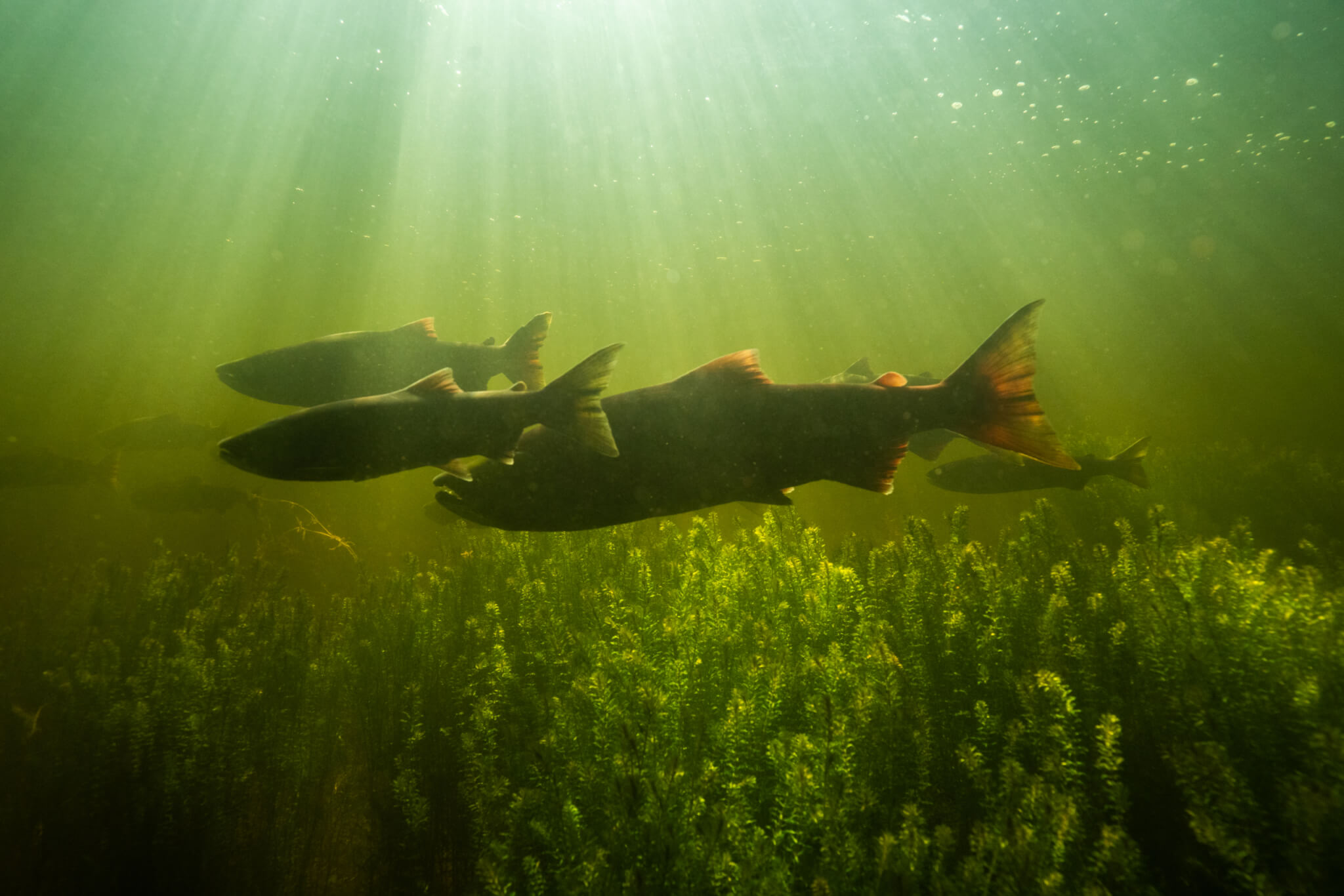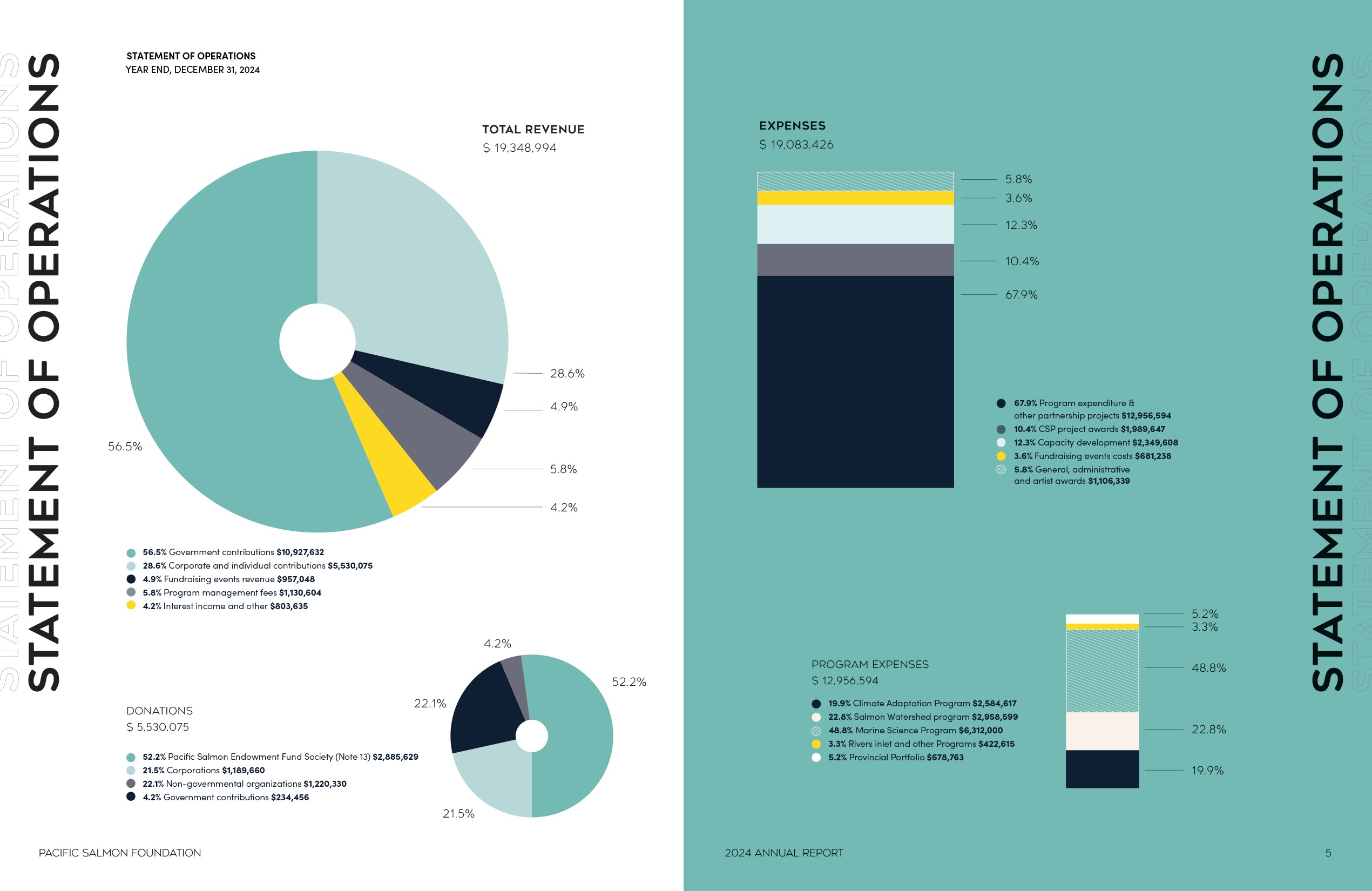Collaborative recovery efforts at the Deadman River in B.C.’s Interior.
Photo: Fisheries and Oceans Canada

At the Pacific Salmon Foundation, we’re all in for salmon. With 70 per cent of Pacific salmon populations in B.C. and the Yukon below their historical long-term average abundances, our mission is more urgent than ever. In 2024, we advanced bold action through science, restoration, and policy, including a landmark open-net pen ban and the launch of our first State of Salmon Report.
Thanks to our partners, donors, and supporters, PSF is leading change for salmon recovery and resilience.
— Michael Meneer, CEO and President, Pacific Salmon Foundation
Read the full CEO message and download the 2024 Annual Report here.

Special thanks to our generous supporters for advancing game-changing work to save and restore wild Pacific salmon.
35 YEARS OF COMMUNITY-LED RECOVERY INITIATIVES
2024 marks the 35th anniversary of the Community Salmon Program – a cornerstone initiative that has been with the Pacific Salmon Foundation (PSF) since the organization’s inception. The Community Salmon Program awards grants to First Nations, stewardship groups, conservation organizations, and schools to advance local salmon restoration initiatives.
With a $118,625 grant from the Community Salmon Program’s 2024 cycle, the Skeetchestn Indian Band has restored salmon habitat in the Deadman River, a key Thompson River tributary supporting pink, coho, Chinook, and steelhead.
Decades of logging and recent wildfires have drastically altered the Lower Deadman. In turn, cottonwood forests – vital for stabilizing banks, providing shade, and sheltering salmon – have been lost.
In partnership with Fisheries and Oceans Canada (DFO), the University of British Columbia, and the Okanagan Nation Alliance, Skeetchestn Indian Band is reintroducing cottonwoods to the Lower Deadman.
In 2024, the team planted nearly 400 cottonwood tree seedlings, as well as more than 600 tree stakes to help stabilize young trees. Additionally, they restored more than 5,000 square metres of riparian, instream, and floodplain habitat.
PSF stewards funds from the Salmon Conservation Stamp on behalf of DFO, along with generous donations, to support hundreds of projects through the Community Salmon Program. Special thanks to the Alastair and Diana Gillespie Foundation, AltaGas, BC Hydro, Domtar, Enbridge, Grassroots Conservation Fund, Industrial Alliance Insurance and Financial Services, Methanex, Mosaic Forest Management, Neptune Terminals, Pembina, Reel Time Fishing Charters and Marine Tours, Seaspan, SECURE Waste Infrastructure, SJ Foundation, Sutherland Foundation, Swiss Water Decaffeinated Coffee, Trans Mountain, and Wolrige Foundation.
Photo: Fisheries and Oceans Canada
“Sitting on PSF’s Grants Committee, I’ve seen the investment the Community Salmon Program makes into communities across the province, and what it does for people and kids. It pulls communities together and creates education and awareness about salmon. It’s really important to continue the Community Salmon Program into the future.” – Murray Ned, Executive Director, Lower Fraser Fisheries Alliance and PSF Board Member
SALMON FARMS BANNED IN BRITISH COLUMBIA
In June 2024, the Government of Canada announced a ban on open-net pen Atlantic salmon farms in British Columbia by 2029.
As a leader in research on the risks of pathogen transmission from farmed to wild salmon, the Pacific Salmon Foundation (PSF) supports this decision to prioritize the health of wild salmon. Since 2013, PSF and its partners have built a growing body of dozens of independent, peer-reviewed publications on the risks open-net pen salmon farms pose to wild salmon.
PSF researchers, in collaboration with many partners including the Broughton Aquaculture Transition Initiative (BATI), a project led by the Mamalilikulla, ‘Na̱mg̱is and Kwikwasut’inux Haxwa’mis First Nations, have studied dozens of infectious agents and risks of spillover from farmed to wild salmon.
A peer-reviewed study published in December 2024, based on monitoring conducted under BATI’s leadership, revealed that the odds of detecting pathogens were 4.3 times higher at active salmon farms than at inactive sites, and even higher for some pathogens of concern. This finding reaffirms that Atlantic salmon farms amplify pathogens and transmit them into B.C., creating exposure risks for wild Pacific salmon migrating through those waters.
Special thanks to the North Family Foundation for their support of PSF’s Salmon Health Program.
“The Pacific Salmon Foundation’s independent science has been instrumental in providing evidence-based data and research that First Nations can use when making decisions about the future of open-net pen salmon farms in their territories. As legal counsel to several First Nations, I’ve seen firsthand how PSF’s research has helped assess potential risks to wild salmon and inform decisions about their lands, waters, and resources.” – Brenda Gaertner, Senior Counsel, Mandell Pinder LLP, and PSF Board Emeritus.
STATE OF SALMON
With more than 10,000 distinct salmon populations across British Columbia and the Yukon, determining the state of salmon is complicated. Yet it’s key to knowing where action is needed and how to best target efforts to help salmon recover.
In 2024, the Pacific Salmon Foundation (PSF) released a State of Salmon report – the first of its kind to assess the state of each species of Pacific salmon and steelhead across B.C. and the Yukon. Before this report, mixed messages ranging from record-high salmon runs to unprecedented fishing closures often painted a confusing picture.
Grounded in data, PSF’s first-ever State of Salmon report shows widespread declines in salmon coupled with encouraging signs of recovery for some species in some regions.
Overall, more than 70 per cent of salmon are below their historical long-term average. Of all species, chum salmon and steelhead are struggling the most.
However, the report also shows signs of hope. For example, coho salmon from the Fraser River and Chinook salmon from Vancouver Island and Mainland Inlets are above their long-term averages.
Learn more: stateofsalmon.ca
Photo: Brandon Deepwell
“The State of Salmon report underscores the Pacific Salmon Foundation’s efforts to modernize the systems that manage salmon in British Columbia. The challenges facing salmon today are far more complex than they were when these frameworks were first established decades ago. With access to data-driven insights like never before, we now have the tools, and the responsibility, to take decisive action to protect and rebuild salmon for generations to come.” – Michael Meneer, CEO and President, Pacific Salmon Foundation
CLOSING REMARKS FROM THE CEO
The Pacific Salmon Foundation (PSF)’s strategic plan will guide our work over the next five years. We will continue leading salmon recovery, building resilience, and modernizing salmon management systems and approaches during an era underscored by the challenges of climate change and the importance of reconciliation.
Our ongoing priorities include:
Together with our many partners, PSF looks forward to advancing these objectives, and more.
We are honoured to work alongside a passionate and dedicated salmon community, including First Nations, researchers, streamkeepers, and countless others. The future for salmon is bright when we bring our knowledge, commitment, and hearts together.
Through meaningful collaboration, we create real change, and renewed hope, for Pacific salmon.
– Michael Meneer, CEO and President, Pacific Salmon Foundation
The progress made for salmon in 2024 would not be possible without you – the Pacific Salmon Foundation’s growing network of partners, supporters, and donors.
Special thanks to:
Each individual who has made a donation in support of PSF’s work to save and restore wild Pacific salmon
1,003 new donors, including individuals, companies, and foundations
450+ individuals who attended the inaugural B.C. Salmon Recovery and Resilience Conference
Hundreds of sponsors and supporters who raised funds at PSF events
Thousands of salmon supporters that celebrated Wild Salmon Day and Salmon Spotting
Province of British Columbia
Fisheries and Oceans Canada
Pacific Salmon Endowment Fund Society